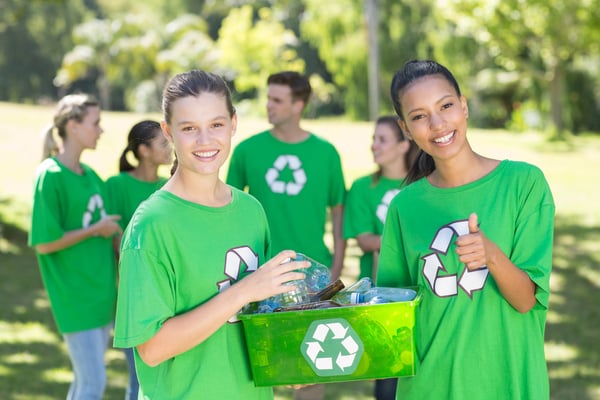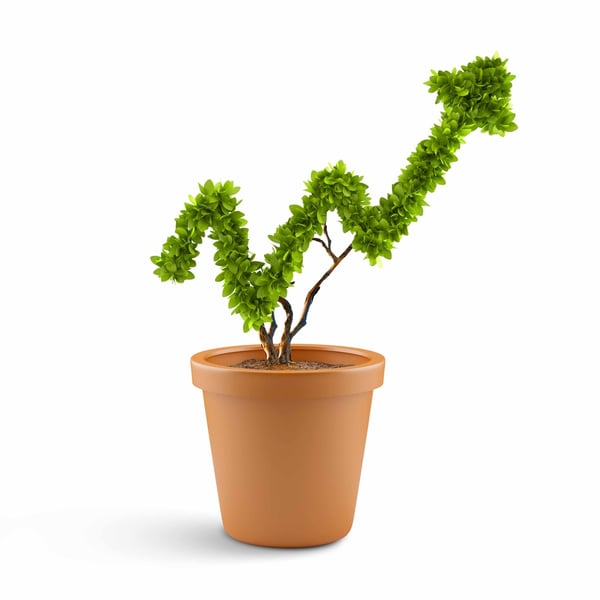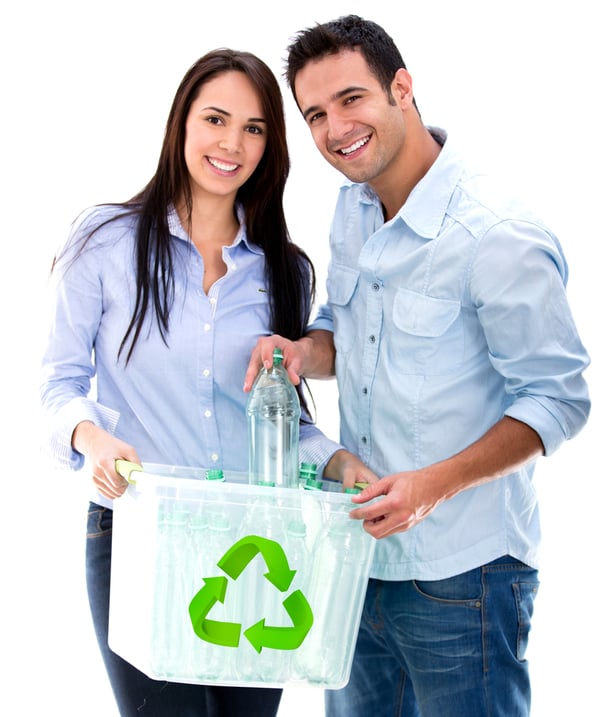Biopolymers, Biodegradable & Recyclable Materials Are The Future Of Plastic Packaging
When it comes to packaging materials, the shocking truth is that plastics are STILL your most environmentally-friendly choice. Three independent studies, including one from the UK government, confirm this scientific truth. And while flexible packaging materials are your best earth-friendly choice, for the time being, the future holds many surprises and innovations.
With that being said, you are probably wondering, how can plastics possibly be our most environmentally friendly choice at this time? We get this question a lot here at Industrial Packaging, and the answer comes down to the science of carbon emissions. Simply put, plastics have the lowest carbon footprints of the most commonly used packaging materials.
Regardless of that fact, we have to ponder what materials will eventually replace plastic altogether? In the article below, we will investigate modern packaging materials, their environmental impact, and the future of packaging supplies.
Polymers: The Building Blocks Of Flexible Packaging
Polymers are the chemical compounds that make up the various types of plastic used throughout the world today. They are the microscopic building blocks of plastic packaging materials.
A polymer is a big molecule that is made out of many smaller components. There are both synthetic and natural polymers at work in the world today, and they are used in millions of different products the world over. Examples of conventional polymers include but are not limited to; synthetic plastics such as polyvinyl chloride (PVC), polyethylene (PE), and polyolefin (POF).
Some polymers exist naturally, such as those that form proteins. These kinds of polymers are ubiquitous throughout nature. Polymers are formed from smaller molecules called monomers, which are organized into larger structures. This process is called polymerization. It works by forming monomers into chain link or three-dimensional networks. This process can be done artificially in a lab with chemicals but also occurs naturally in nature.
When it comes to plastic polymers, each type allows for variations in strength, elasticity, and physical structure. Depending on the type of plastic substrate you are using, it may be made of one or more polymers.
Looking for sustainable packaging? We can help!
Sustainable Plastic Packaging: A Common Misconception
There is a lot of misinformation about the recycle-ability of plastic being circulated through the internet these days. While plastics have become a noticeable problem for our oceans, in particular, there are other environmental problems with them as well.
Additionally, health issues with the expansion of micro-plastics, which eventually make their way into our air supply, further exasperate the ecological dilemmas with the material.
However, many of the problems surrounding plastic have to do with improper recycling. These are both issues in which the individual consumer and the corporation alike need to take into consideration. We need to be honest with ourselves and protect our planet earth.

What Are Your Recyclable Packaging Options?
Despite the problems and concerns that we collectively have with plastics, flexible packaging materials like shrink film are still the least harmful packaging materials we currently have available and shrink film is recyclable.
As mentioned earlier, plastics have their problems when it comes to the environment. But science proves that plastics are still more earth-friendly than the most common alternatives such as glass, cardboard, metal, and canvass.
Each of these alternatives has a significantly higher carbon footprint. Using these materials in place of plastics for packaging would result in a significant increase in pollution.
Biodegradable Packaging Options: Biopolymers and Bioplastics
Biopolymers are polymers that are created from organic and plant-based materials such as rice. They are being developed by various companies and laboratories across the globe. These miraculous materials will likely be the building blocks of the packaging supplies of the future.
Biopolymers are used in the creation of bioplastics, which unlike their purely synthetic counterparts, biodegrade in a short amount of time. Traditional plastics can take thousands of years to break down.
Bioplastics offer consumers a genuinely earth-friendly plastic hybrid, albeit often with a higher price tag. That being said, as the technology behind bioplastics evolves, the cost of the material is expected to decrease over time while the adoption of the materials is expected to increase. This is likely to lead to broader adoption of the materials over time.

But what exactly is a bioplastic?
From Sciencedirect.com:
"Bioplastics are made wholly or in part from renewable biomass sources such as sugarcane and corn, or from microbe such as yeast. Some bioplastics are biodegradable or even compostable under the right conditions. Bioplastics made from renewable resources can be naturally recycled by biological processes, thus limiting the use of fossil fuels and protecting the environment.
Therefore, bioplastics are sustainable, largely biodegradable, and biocompatible. Today, bioplastics have become a necessity in many industrial applications such as food packaging, agriculture and horticulture, composting bags, and hygiene.
Bioplastics have also found their use in biomedical, structural, electrical, and other consumer products. With increasing demand for global plastic consumption, a lot of research is being dedicated toward exploring green materials and new ways to process them."
What Are The Packaging Materials Of The Future?
We have done much research on plastics and the most common alternatives for packaging. Unfortunately, the most common alternatives to plastic (glass, metal, cardboard, and canvass) all have significantly higher carbon footprints due to their weight.
Shifting from plastics to these other materials is resulting in exponentially more pollution being moved from our oceans to our air supply. Multiple science-based studies, including one by the UK Environmental Agency, confirm this frightening reality.
And while plastics are not technically "earth-friendly" in the way that we would like to define that term, they are currently the most earth-friendly option we have.
Furthermore, recycling is essentially a commodity in the waste management industry with a lower and lower value as time goes on since china no longer accepts many of our shipments. We used to sell millions of pounds of recyclable materials to China for processing however; those days are over.
With about 25% of recycling being contaminated, a large portion of it goes into landfills. Most US-based waste management companies do not want to deal with the contaminated waste or employ human labor to try and sort it out. In China, low paid workers were tasked to do just that, but that is not the case here in the USA.
From The Atlantic:
"About 25 percent of what ends up in the blue bins is contaminated, according to the National Waste & Recycling Association. For decades, we’ve been throwing just about whatever we wanted—wire hangers and pizza boxes and ketchup bottles and yogurt containers—into the bin and sending it to China, where low-paid workers sorted through it and cleaned it up. That’s no longer an option. And in the United States, at least, it rarely makes sense to employ people to sort through our recycling so that it can be made into new material, because virgin plastics and paper are still cheaper in comparison.
Even in San Francisco, often lauded for its environmentalism, waste-management companies struggle to keep recycling uncontaminated. I visited a state-of-the-art facility operated by San Francisco’s recycling provider, Recology, where million-dollar machines separate aluminum from paper from plastic from garbage. But as the Recology spokesman Robert Reed walked me through the plant, he kept pointing out nonrecyclables gumming up the works. Workers wearing masks and helmets grabbed laundry baskets off a fast-moving conveyor belt of cardboard as some non-cardboard items escaped their gloved hands. Recology has to stop another machine twice a day so a technician can pry plastic bags from where they’ve clogged up the gear."
![]()
Most waste management companies are recycling only a portion of our single-stream recycling. Much of the material is going into landfills due to contamination from liquids and food.
Most businesses will not shift to real earth-friendly alternatives such as biopolymer, bioplastic, and plant-based plastics. Instead, they have opted to use the alternative materials mentioned above (glass, metal, etc.) because of the poor association of plastics.
Want To Learn More?
Plastics need to be replaced with materials like rice-based plastic alternatives. Still, these materials are currently more costly, and most businesses will not adopt these options due to the cost of those materials.
For the time being, plastics, particularly soft, flexible packaging varieties, are the least detrimental to our environment, despite their effect on our oceans. These problems are primarily a byproduct of lousy recycling and waste management practices.
Both individual consumers and corporations alike need to start implementing better recycling habits. The nature of modern recycling needs to be addressed and re-thought by both parties to improve the process so that more of the recyclable materials we make get recycled.

Hopefully, human ingenuity will expedite the scientific advancements in plant-based biopolymers and find a way to reduce their cost. Furthermore, implementing the plastic-eating bacteria and fungus varieties that have been recently discovered via a global initiative may help to remove some of the plastic we have created in the past.
In conjunction with the expansion of the ocean cleanup projects that are currently underway, using these new opportunities in conjunction with improved recycling practices could help us to greatly reduce the waste plastic currently on planet earth. As we slowly shift to biodegradable alternatives, all of these initiatives may provide hope for a more sustainable future.
Until then, using flexible packaging materials while pushing ourselves to be better at recycling these items is our best option.
How To Source Sustainable Packaging Materials
When looking to source sustainable packaging materials, you should contact at least 3 to 4 vendors and compare the offerings of each. Ask for information for each type of material you are interested in and have a packaging expert from each vendor send you information about the materials.
If possible, have a rep from each vendor come in and take a look at your packaging line, current machinery, materials, and products. Ask them to analyze each of the above. This will provide them with the information necessary to provide you with a comprehensive set of data supporting why they think their offerings will be a good fit for you as a client.
Also, do not always choose your materials based solely on price, especially if sustainability is a significant concern for your business. Sometimes, environmentally friendly options cost more to produce and thus will cost more for you to run on your packaging line. It would be wise to compare the cost, features, pros, and cons of several different material options and choose one based upon your specific needs.
About Nathan Dube
As the Digital Marketing Specialist at Industrial Packaging, I am honored to create content for such a phenomenal company and work with one of the greatest teams in the Packaging Industry. Whether creating a video, writing blog posts or generating other pieces of content and multimedia, I am always excited to help educate and inspire our prospects and clients to reach their highest potential in regards to their packaging processes and needs.




